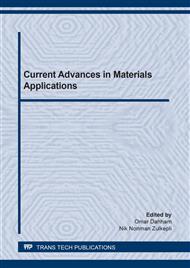[1]
W. K. Goertzen, M. R. Kessler, Creep behavior of carbon fiber/epoxy matrix composites, Materials Science and Engineering part A. 421 (2006) 217-225.
DOI: 10.1016/j.msea.2006.01.063
Google Scholar
[2]
A. Plaseied, A. Fatemi, Tensile creep and deformation modeling of vinyl ester polymer and its nanocomposites, Journal of Reinforced Plastics and Composites. 28 (2008) 1775-1788.
DOI: 10.1177/0731684408090378
Google Scholar
[3]
A. D. Drozdov, Creep rupture and viscoelastoplasticity of polypropylene, Engineering Fracture Mechanics. 77 (2010) 2277-2293.
DOI: 10.1016/j.engfracmech.2010.05.010
Google Scholar
[4]
V. S. Chevali, D. R. Dean, G. M. Janowski, Flexural creep behavior of discontinuous thermoplastic composites: non-linear viscoelastic modeling and time-temperature-stress superposition, Composites: part A. 40 (2009) 870-877.
DOI: 10.1016/j.compositesa.2009.04.012
Google Scholar
[5]
W. N. Findley, J. S. Lai, K. Onaran, Creep and relaxation of nonlinear viscoelastic materials with an introduction to linear viscoelasticity, North-Holland publishing company (1976).
DOI: 10.1016/b978-0-7204-2369-3.50003-5
Google Scholar
[6]
J. L. Yang, Z. Zhang, A. K. Schlarb, K. Friedrich, On the characterization of tensile creep resistance of polyamide 66 nanocomposites. Part II: Modeling and prediction of long-term performance, Polymer. 47 (2006) 6745-6758.
DOI: 10.1016/j.polymer.2006.07.060
Google Scholar
[7]
K. Banik, J. K. Kocsis, T. Abraham, Flexural Creep of All-Polypropylene Composites: Model Analysis, Polymer engineering and science. 48 (2008) 941-948.
DOI: 10.1002/pen.21041
Google Scholar
[8]
Y. Nakazato, S. Zhu, A. Usuki, M. Kato, Analysis and prediction of creep viscoelasticity in nylon 6 clay hybrid nanocomposites, Journal of solid mechanics and material engineering. 4 (2010) 856-863.
DOI: 10.1299/jmmp.4.856
Google Scholar
[9]
Y. Jia, K. Peng, X. L. Gong, Z. Zhang, Creep and recovery of polypropylene/carbon nanotube composites, International Journal of Plasticity. 27 (2011) 1239–1251.
DOI: 10.1016/j.ijplas.2011.02.004
Google Scholar
[10]
Y. L. Li, M. Y. Shen, W. J. Chen, C. L. Chiang, M. C. Yip, Tensile creep study and mechanical properties of carbon fiber nano-composites, Journal of polymer research. 19 (2012).
DOI: 10.1007/s10965-012-9893-6
Google Scholar
[11]
Z. Yao, D. Wu, C. Chen, M. Zhang, Creep behavior of polyurethane nanocomposites with carbon nanotubes, Composites: Part A. 50 (2013) 65-72.
DOI: 10.1016/j.compositesa.2013.03.015
Google Scholar
[12]
M. Eftekhari, A. Fatemi, Creep behavior and modeling of neat, talc-filled, and short glass fiber reinforced thermoplastics, Composites Part B. 97(2016) 68-83.
DOI: 10.1016/j.compositesb.2016.04.043
Google Scholar
[13]
Chang. M. Wu, P. C. Lin, R. Murakami, Long-term creep behavior of self-reinforced PET composites, Express Polymer Letters. 11 (2017) 820–831.
DOI: 10.3144/expresspolymlett.2017.78
Google Scholar
[14]
N. P. Lorandi, M. O. Cioffi, C. Shigue, H. L. Ornaghi, On the creep behavior of carbon/epoxy non-crimp fabric composites, Materials Research. 21 (2018).
DOI: 10.1590/1980-5373-mr-2017-0768
Google Scholar
[15]
ASTM D2990 standard test method for tensile, compressive, flexural creep and creep- rupture of plastics.
DOI: 10.1520/d2990-01
Google Scholar


